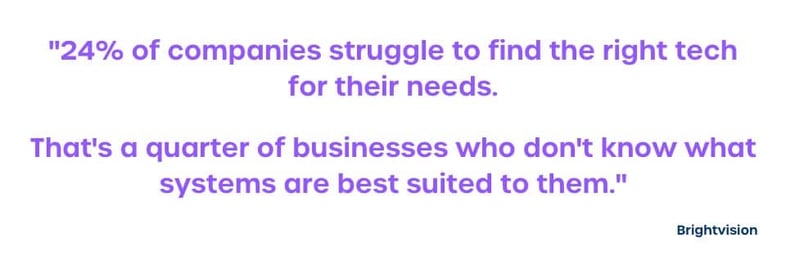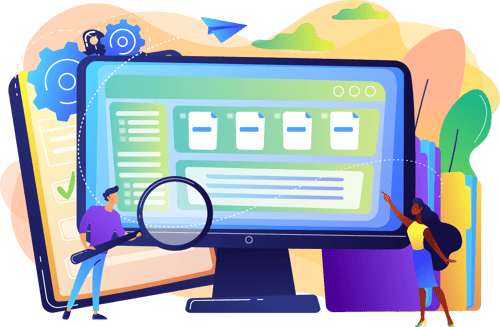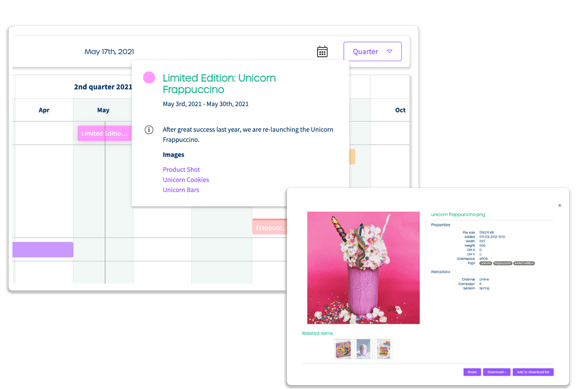
DAM vs MRM vs PIM: which system is right for you?
Last updated: October 7, 2025
Key Takeaways:
- DAM (Digital Asset Management) and MRM (Marketing Resource Management) are both essential tools for localized marketing, but they serve different purposes.
- DAM focuses on storing, organizing, and distributing digital assets, ensuring brand consistency across all locations.
- MRM is designed to manage marketing operations, streamline campaign planning, allocate resources, and measure results.
- Choosing the right system depends on your biggest marketing challenges, what you’re selling, and whether you need internal or external access.
Tech has birthed great things for marketing; automation, data analysis, machine learning and software have all helped marketers save time and money while speeding up their processes.
However, as well as birthing all of these juicy benefits, it’s also brought a whole load of confusing acronyms with it, including CMS, CRM, DAM, MRM, and PIM.
The slew of letters and accompanying complex systems is difficult for a lot of business owners to get their heads around.
In response to this, we’ve put together a guide that will clear the confusion and will help you choose the right system.

Why do marketers need to understand DAM and MRM?
With so many marketing acronyms and tools available, it’s easy to get confused. DAM and MRM are two of the most important systems for brands running localized campaigns, especially for multi-location businesses. Understanding their differences helps you pick the right solution to support your local marketing goals.
What is a DAM (Digital Asset Management) system and how does it support localized marketing?
A DAM system is a centralized platform for storing, organizing, and distributing digital assets—like logos, images, videos, and documents. For localized marketing, DAM ensures every location has access to the latest, approved brand materials, making it easy to maintain brand consistency across all channels and regions.
DAM is ideal if you need to:
- Store and manage a large volume of digital assets
- Streamline content approval and distribution
- Protect your brand and ensure consistency
- Distribute assets quickly to all your digital channels
What is an MRM (Marketing Resource Management) system and how does it support localized marketing?
MRM software is designed to manage the entire marketing operation. It helps you plan, track, and report on campaigns, allocate budgets, manage workflows, and ensure all marketing content is brand-compliant. For localized marketing, MRM makes it easier to coordinate campaigns across multiple locations, optimize resources, and measure what’s working at each branch.
MRM is ideal if you need to:
- Plan and manage complex, multi-location campaigns
- Allocate resources and budgets efficiently
- Track campaign performance and ROI
- Safeguard brand compliance and consistency
What Is a PIM (Product Information Management) System and How Does It Support Localized Marketing?
A PIM software is designed to centralize and manage all product-related information in one place. It ensures that data such as descriptions, specifications, pricing, and digital assets are accurate, consistent, and up to date across every sales and marketing channel. For localized marketing, a PIM helps you easily adapt product information to different regions, languages, and market needs, while safeguarding brand and data consistency.
PIM is ideal if you need to:
-
Centralize and enrich product information for multiple channels
-
Localize product data for different markets and languages
-
Ensure accuracy and consistency across catalogs, e-commerce, and marketing materials
-
Accelerate time-to-market for new product launches
-
Reduce manual errors and inefficiencies in product content management

Do You Choose Between DAM and MRM for Your Localized Marketing Needs?
If finding the right tools is a challenge for you, you are not the only one. A study by Brightvision revealed that 24% of companies struggle to find the right tech for their needs. That's a quarter of businesses who don't know what systems are best suited to them. That's why we help you determine which system is right for you in three steps.
1. What is your biggest challenge?
A report from WARC cited the top challenges marketers are set to face this year. Problems include growing in a slow economy (16%), managing big data (13%), digital transformation (13%), and building a purposeful brand (13%).
So how can choosing the right tech solution help get you past these stumbling blocks? The key is identifying which challenge is your biggest hurdle and working backwards from there.
.png?width=700&name=brand%20marketers%20biggest%20challenge%20(1).png) If you struggle with growth in a slow economy, you might want to double down on brand building activities or adding more products to your pipeline. If your biggest challenge is managing content, you might need somewhere to store all data and a workflow for analysing it. If digital transformation is holding you back, you might need to gather your digital assets and experiment with different digital activities.
If you struggle with growth in a slow economy, you might want to double down on brand building activities or adding more products to your pipeline. If your biggest challenge is managing content, you might need somewhere to store all data and a workflow for analysing it. If digital transformation is holding you back, you might need to gather your digital assets and experiment with different digital activities.
The easiest way to do this is to think about the “big picture” you have for your business and what’s stopping you from getting there. Often, your “big picture” goal will reveal your biggest marketing challenge.
.png?width=750&name=big%20picture%20goals%20for%20companies%20(1).png)
For some businesses, deploying effective local marketing campaigns can be a real sticking point. In particular, creating appealing local content that resonates with specific franchisers and tapping into effective marketing operations to run these campaigns. For others, it’s maintaining brand consistency and keeping up a strong brand reputation.
For example, your “big picture” goal might be to double your sales in the next 12 months. Your smaller goals might include running a brand awareness marketing campaign and adding multiple new in-demand products to your catalogue to encourage those extra sales.
Once you’ve got those smaller goals in mind, it’s important to pick apart the elements that go into them to decide which kind of system meets your needs best.
2. What are you selling?
No two businesses are the same, and it’s important that you know exactly what you’re selling to your customers and why. For many businesses, this is a simple question to answer because they are selling physical products. For others, it’s slightly trickier because they are selling consultations, software solutions, or services that aren’t tangible. This information is important because some systems are better suited to physical products than others.
3. Internal or external system?
The final step in choosing the right system for you is deciding whether you want your system to be externally facing or used only among your internal team. Again, this goes back to the goals you have for your business and the kind of offerings you have. So, if you’re struggling with this step, go back to rounds one and two and dig deeper.
Which system is right for you?
While PIM, DAM, and MRM solutions all share some similarities, they are ultimately different systems that serve different purposes.
You don’t have to stick to just one - in fact, you can use multiple solutions to manage different parts of your business, but you don’t want to overwhelm yourself and your team by having too many systems that need to constantly be checked and updated.
Instead, think about your “big picture” goals and how you’re going to get there. The key question here is “where do you begin”? From there, you can work with open systems that can be connected to certain standards in the market via APIs. You can then start thinking about what support you need along the way and what tools and assets will help you get there.
While DAM and MRM solutions are perfectly designed to handle digital assets, they can also be useful for developing and organising marketing campaigns for physical product companies. It’s simply a case of choosing a solution that’s right for you and
your business.
How we can help
If this article has made you realize you need a DAM or MRM solution, make sure you request a demo of our software. Our experts will further explore your needs and determine which of our solutions best matches your wishes and goals.
Unsure if your business needs a DAM, MRM, or PIM? Schedule a demo with Marvia and let's identify the solution that best tackles your specific marketing challenges.
> Click here to request your free demo today!
Frequently asked questions (FAQ) about local store marketing for restaurants
What is the main difference between DAM and MRM?
DAM manages digital assets (like images and videos), while MRM manages marketing operations (like campaign planning, budgeting, and reporting).
Can I use both DAM and MRM in my business?
Yes! Many brands use both to manage assets and campaigns more effectively, especially when running localized marketing across multiple locations.
Which system should I start with?
Start with the system that addresses your biggest challenge, asset management (DAM) or campaign operations (MRM). You can always integrate more tools as your needs grow.
Is DAM or MRM better for brand consistency?
Both help with brand consistency: DAM ensures everyone uses approved assets, while MRM enforces brand guidelines in campaign execution.
How do I know if I need a PIM as well?
If you manage a large product catalog and need to distribute product information across channels, a PIM (Product Information Management) system may also be necessary.

